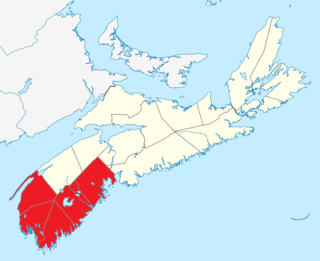Forties Settlement is a community in the Canadian province of Nova Scotia, located in the Chester Municipal District .
Coordinates: 44°44′2.59″N64°33′3.09″W / 44.7340528°N 64.5508583°W
Forties Settlement is a community in the Canadian province of Nova Scotia, located in the Chester Municipal District .
Coordinates: 44°44′2.59″N64°33′3.09″W / 44.7340528°N 64.5508583°W

Westport, Nova Scotia is a village in Digby County, Nova Scotia and it is located on Brier Island in the Bay of Fundy. As of 2021, the population was 193.
Beaubassin was an important Acadian village and trading centre on the Isthmus of Chignecto in what is now Nova Scotia, Canada. The area was a significant place in the geopolitical struggle between the British and French empires. It was established in the 1670s on an upland close to an extensive area of saltwater marsh. Settlers reclaimed the land to engage in cattle ranching and trade.
The Lighthouse Route is a scenic roadway in the Canadian province of Nova Scotia. It follows the province's South Shore for 585 km (364 mi) from Halifax to Yarmouth.

The Municipality of the District of Chester is a Nova Scotia district municipality occupying the northeastern half of Lunenburg County, Canada.

The Ross Farm Museum is an agricultural museum located in New Ross, Nova Scotia, about an hour's drive from Halifax.

River John is a river in Nova Scotia. Draining the extreme western part of Pictou County, it flows into Amet Sound on the Northumberland Strait at River John, a village which takes its name from the river. The Miꞌkmaq name is Kajeboogwek. An early name was Deception River. Its present name is believed to derive from Rivière Jaune, an Acadian name, though it may also derive from nearby Cap Jean. DesBarres called it River John in his Atlantic Neptune.

Queensland is a community of the Halifax Regional Municipality in the Canadian province of Nova Scotia.
Simms Settlement is a rural community of the Municipality of The District of Chester in the Canadian province of Nova Scotia.
The Lodge is a small community in the Canadian province of Nova Scotia, located in the Chester Municipal District on the Aspotogan Peninsula. Its only significant road is Nova Scotia Route 329, on the Lighthouse Route.
Blockhouse is a community in the Canadian province of Nova Scotia, located in the Lunenburg Municipal District in Lunenburg County. It was named after the blockhouses constructed by Captain Ephraim Cook to protect colonists following a raid in 1756. The final blockhouse in the community burned down in 1874.
Bakers Settlement is a community in the Canadian province of Nova Scotia, located in the Lunenburg Municipal District in Lunenburg County.
Crouse's Settlement is a community in the Canadian province of Nova Scotia, located in the Lunenburg Municipal District in Lunenburg County.
Forties is a community in the Canadian province of Nova Scotia, located in the Lunenburg Municipal District in Lunenburg County.
Grimm's Settlement is a community in the Canadian province of Nova Scotia, located in the Lunenburg Municipal District in Lunenburg County.
Tanner's Settlement is a community in the Canadian province of Nova Scotia, located in the Lunenburg Municipal District in Lunenburg County. It is northeast of Grimm's Settlement and east of Cosman's Meadow.

Beach Meadows is a settlement in the Region of Queens Municipality, Nova Scotia, Canada. It is the site of Beach Meadows Beach Park.
There are various Black Lakes in Nova Scotia, Canada. They vary widely in size, depth and usability. Many counties, such as Cumberland, Halifax, Inverness, and Pictou Counties have more than one Black Lake so named, while other counties mentioned in this article have only one named Black Lake.

Southern Nova Scotia or the South Shore is a region of Nova Scotia, Canada. The area has no formal identity and is variously defined by geographic, county and other political boundaries. Statistics Canada, defines Southern Nova Scotia as an economic region, composed of Lunenburg County, Queens County, Shelburne County, Yarmouth County, and Digby County. According to Statistics Canada, the region had the highest decrease of population in Canada from 2009 to 2010, with a population decrease of 10.2 residents per thousand. The region also has the second-highest median age in Canada at 47.1 years old.

A township in Nova Scotia, Canada, was an early form of land division and local administration during British colonial settlement in the 18th century. They were created as a means of populating the colony with people loyal to British rule. They were typically rural or wilderness areas of around 100,000 acres (400 km2) that would eventually include several villages or towns. Some townships, but not all, returned a member to the General Assembly of Nova Scotia; others were represented by the members from the county. Townships became obsolete by 1879 by which time towns and counties had become incorporated.